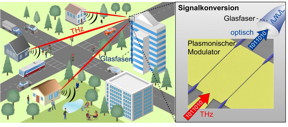Technologies for the Sixth Generation Cellular Network: Ultra-rapid Electro-optical Modulators Convert Terahertz into Optical Data Signals - Publication in Nature Photonics
Future wireless data networks will have to reach higher transmission rates and shorter delays, while supplying an increasing number of end devices. For this purpose, network structures consisting of many small radio cells will be required. To connect these cells, high-performance transmission lines at high frequencies up to the terahertz range will be needed. Moreover, seamless connection to glass fiber networks must be ensured, if possible. Researchers of Karlsruhe Institute of Technology (KIT) use ultra-rapid electro-optical modulators to convert terahertz data signals into optical signals.
While the new 5G cellular network technology is still tested, researchers are already working on technologies for the next generation of wireless data transmission. "6G" is to reach far higher transmission rates, shorter delays, and an increased device density, with artificial intelligence being integrated. On the way towards the sixth generation cellular network, many challenges have to be mastered regarding both individual components and their interaction. Future wireless networks will consist of a number of small radio cells to quickly and efficiently transmit large data volumes. These cells will be connected by transmission lines, which can handle tens or even hundreds of gigabits per second per link. The necessary frequencies are in the terahertz range, i.e. between microwaves and infrared radiation in the electromagnetic spectrum. In addition, wireless transmission paths have to be seamlessly connected to glass fiber networks. In this way, the advantages of both technologies, i.e. high capacity and reliability as well as mobility and flexibility, will be combined.

Seamless integration of wireless transmission lines into glass-fiber networks results in high-performance data networks. A detailed description of the figure is given at the end of the text.
Scientists of the KIT Institutes of Photonics and Quantum Electronics (IPQ), Microstructure Technology (IMT), and Radio Frequency Engineering and Electronics (IHE) and the Fraunhofer Institute for Applied Solid State Physics IAF, Freiburg, have now developed a promising approach to converting data streams between the terahertz and optical domains. As reported in Nature Photonics, they use ultra-rapid electro-optical modulators to directly convert a terahertz data signal into an optical signal and to directly couple the receiver antenna to a glass fiber. In their experiment, the scientists selected a carrier frequency of about 0.29 THz and reached a transmission rate of 50 Gbit/s. "The modulator is based on a plasmonic nanostructure and has a bandwidth of more than 0.36 THz," says Professor Christian Koos, Head of IPQ and Member of the Board of Directors of IMT. "Our results reveal the great potential of nanophotonic components for ultra-rapid signal processing." The concept demonstrated by the researchers will considerably reduce technical complexity of future radio base stations and enable terahertz connections with very high data rates - several hundred gigabits per second are feasible.
Source : Nanotechnology Now
- 208 reads
Human Rights
Ringing FOWPAL’s Peace Bell for the World:Nobel Peace Prize Laureates’ Visions and Actions

Protecting the World’s Cultural Diversity for a Sustainable Future

The Peace Bell Resonates at the 27th Eurasian Economic Summit

Declaration of World Day of the Power of Hope Endorsed by People in 158 Nations

Puppet Show I International Friendship Day 2020

